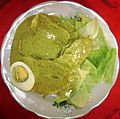Tagetes minuta facts for kids
Quick facts for kids Tagetes minuta |
|
|---|---|
 |
|
| Scientific classification | |
| Genus: |
Tagetes
|
| Species: |
minuta
|
| Synonyms | |
|
|
Tagetes minuta is a tall plant that belongs to the marigold family. It is originally from the southern part of South America. This plant is known by many different names around the world. Some common names include southern marigold, khakibos, stinking roger, wild marigold, and black mint. In the Andes mountains, people often call it Huacatay or Wacatay.
After the Spanish arrived in the Americas, this plant spread to many other places. Now, you can find it growing naturally in Europe, Asia, Australia, North America, and Africa.
Contents
About This Plant
This type of marigold can grow quite tall. It usually reaches a height of about 0.6 to 2 meters (which is about 2 to 6.5 feet).
How People Use It
People have used Tagetes minuta for a long time, even before Christopher Columbus came to the Americas.
In Cooking
This plant is a popular herb used in cooking, especially in countries like Peru, Ecuador, Chile, and Bolivia. In Peru, it is called huacatay and in Bolivia, it is known as wakataya.
- Seasoning: Dried leaves of the plant can be used to add flavor to food.
- Paste: You can often find huacatay sold as a paste in Latin grocery stores. This "black mint paste" is used to make a famous Peruvian potato dish called ocopa.
- Herbal Tea: People also make a warm herbal tea from the leaves of the plant.
Other Uses
Besides food, Tagetes minuta has other interesting uses:
- Dye: The plant can be used to make dye for coloring things.
- Gardening: Farmers sometimes use it as a "green manure" crop. This means they grow it to improve the soil. It can also help control tiny worms in the soil called nematodes.
- Fragrance: An oil from the plant, called "Marigold oil," is used in perfumes, tobacco, and even some soft drinks to add a special scent or flavor.
Things to Know About This Plant
The oils in the plant's leaves and stems can sometimes irritate the skin for some people. If you touch the plant, it's a good idea to wash your hands afterward. In some rare cases, it might make skin more sensitive to sunlight.
Gallery
See also
 In Spanish: Huacatay para niños
In Spanish: Huacatay para niños






